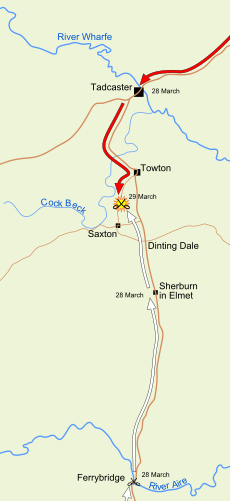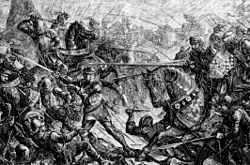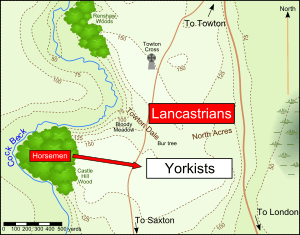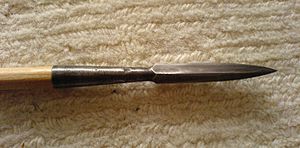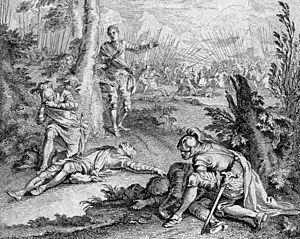Battle of Towton facts for kids
Quick facts for kids Battle of Towton |
|||||||
|---|---|---|---|---|---|---|---|
| Part of the Wars of the Roses | |||||||
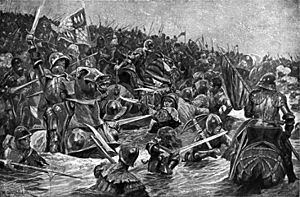 The Battle of Towton, Richard Caton Woodville Jr. (1922) |
|||||||
|
|||||||
| Belligerents | |||||||
| Commanders and leaders | |||||||
| Strength | |||||||
| 50,000–60,000 men (modern estimates) | |||||||
| Casualties and losses | |||||||
| 800 or more killed | c.3000–9,000 killed | ||||||
The Battle of Towton was a huge fight that happened on 29 March 1461. It took place near the village of Towton in Yorkshire, England. This battle was part of the Wars of the Roses, a series of civil wars in England. It is thought to be the biggest and bloodiest battle ever fought on English land.
About 50,000 to 60,000 soldiers fought for many hours during a snowstorm. This day was Palm Sunday, an important Christian holiday. The battle changed who was king of England. Edward IV of the House of York became king. He took the place of Henry VI of the House of Lancaster. The House of York then ruled England, and the Lancastrians were forced out.
King Henry VI was not a strong ruler and sometimes had mental health problems. This made powerful nobles want to control him. By the 1450s, this led to a civil war. It was between supporters of Queen Margaret of Anjou and those who backed Henry's cousin, Richard, Duke of York. In 1460, the English Parliament decided that York would become king after Henry died.
But Queen Margaret did not agree with this. She did not want her son, Edward, to lose his right to the throne. She gathered a large army. Her army then defeated and killed Richard, Duke of York. York's supporters felt the Lancastrians had broken a legal agreement. So, York's son, Edward, declared himself king. The Battle of Towton was fought to decide who would truly rule England.
When the Yorkists arrived at the battlefield, they were outnumbered. Part of their army, led by the Duke of Norfolk, had not yet arrived. The Yorkist leader, Lord Fauconberg, used a clever plan. He told his archers to use the strong wind to shoot their arrows farther than the enemy. The Lancastrian arrows fell short, but the Yorkist arrows hit their targets.
This one-sided arrow fight made the Lancastrians leave their safe positions. They charged forward to fight hand-to-hand. This close combat lasted for hours, making the soldiers very tired. Then, the Duke of Norfolk's men finally arrived. This gave the Yorkists new energy. Encouraged by Edward, they defeated their enemies. Many Lancastrians were killed while running away. Some were trampled, and others drowned in the rivers. Many who were captured were also killed.
After this battle, the House of Lancaster lost much of its power. Henry VI fled to another country. Many of his strong supporters were dead or in exile. This left Edward IV as the new king of England. Later, people remembered the battle from William Shakespeare's play, Henry VI, Part 3. In 1929, the Towton Cross was put up on the battlefield to remember the event. Years later, archaeologists found human remains and mass graves from the battle.
Contents
What Caused the Battle?
In 1461, England was in its sixth year of the Wars of the Roses. These were civil wars between the York and Lancaster families. Both wanted to control the English throne. The Lancastrians supported King Henry VI. He was often unsure and sometimes had periods of mental illness.
The Yorkist leader was Richard, Duke of York. He was unhappy that a few nobles, especially the Beaufort family, had too much power with the king. These rivalries led to war. In 1460, the Duke of York captured King Henry at the Battle of Northampton. Since York was related to the royal family, he claimed the throne.
Even York's own supporters were hesitant to remove the king completely. So, they passed the Act of Accord. This law said that York and his children would become kings after Henry died.
Queen Margaret of Anjou did not accept this. She did not want her son, Edward, to lose his right to be king. She had gone to Scotland after the Yorkist win at Northampton. There, she started gathering an army. She promised her followers they could take goods from towns as they marched south. Her Lancastrian supporters in northern England also got ready for her arrival.
Richard, Duke of York, marched his army to meet this threat. But he was tricked at the Battle of Wakefield and killed. The Lancastrians cut off the heads of the duke and his second son, Edmund, Earl of Rutland. After this, the leadership of the House of York went to the duke's oldest son, Edward.
The Lancastrian winners of Wakefield joined Margaret's army. They marched south, taking things from towns along the way. They freed King Henry after beating the Yorkist army of Richard Neville, Earl of Warwick, at the Second Battle of St Albans. They kept taking goods as they went towards London. But London refused to let Henry and Margaret in, fearing their city would be looted.
The Lancastrian army was running out of supplies. When Margaret heard that Edward, Earl of March (Richard of York's son), had won the Battle of Mortimer's Cross, she pulled her army back to York. Edward and Warwick's remaining men joined up. The Yorkists were welcomed into London. Since they no longer had King Henry, the Yorkists needed a reason to keep fighting. On 4 March, Warwick announced that the young Edward was now King Edward IV.
Many nobles who had not wanted Edward's father to be king now supported Edward. They saw the Lancastrians' actions as breaking the legal agreement. England now had two kings, which could not continue. Edward offered to forgive any Lancastrian supporter who stopped backing Henry. This offer was for common people, not for rich Lancastrian nobles.
Edward ordered his followers to march towards York. He wanted to take back his family's city and remove Henry from power. The Yorkist army moved in three groups. Warwick's uncle, Lord Fauconberg, led one group to clear the way. Edward led the main army. The Duke of Norfolk went east to gather more soldiers. On 28 March, the Yorkist army reached the River Aire at Ferrybridge. They were rebuilding a bridge when about 500 Lancastrians, led by Lord Clifford, attacked them.
Edward led the main Yorkist army to the bridge. The narrow bridge made it hard to fight, even though the Yorkists had more men. Edward sent Fauconberg and his horsemen to cross the river at Castleford. They attacked Clifford's men from the side. The Lancastrians retreated but were chased and killed. After clearing the area, the Yorkists fixed the bridge. They camped overnight at Sherburn-in-Elmet. The Lancastrian army camped near Tadcaster, about 2 miles north of Towton.
As dawn broke, both armies prepared for battle under dark skies and strong winds. It was Palm Sunday, a holy day. Some called the fight the Battle of Palme Sonday Felde, but the name Towton stuck because it was the closest and most important village.
Who Fought in the Battle?
The armies at Towton were some of the biggest of their time. Old records said hundreds of thousands fought, but this is likely too high. Modern historians think between 50,000 and 65,000 soldiers fought. This was about one to two percent of England's population back then. Studies of 50 skeletons found in mass graves showed most soldiers were 24 to 30 years old. Many had fought in earlier battles.
King Henry's weakness was a big problem for the Lancastrians. He stayed in York with Queen Margaret. In contrast, 18-year-old Edward was tall and strong in his armor. He led his soldiers from the front. His brave attack plans shaped how the Yorkists fought. His presence and example helped the Yorkists stay strong through the long, hard fight.
About three-quarters of England's noble families fought in the battle. Eight noblemen were with the Yorkist army, while at least nineteen were with the Lancastrians.
Among the Yorkist leaders, Warwick was not in the battle. He had hurt his leg at Ferrybridge. Norfolk was too old to fight, so his group was led by Walter Blount and Robert Horne. Edward relied heavily on Warwick's uncle, Lord Fauconberg. He was a skilled soldier from the Anglo-French wars. He had led soldiers in many roles, showing his military talent.
The main Lancastrian general was Henry Beaufort, Duke of Somerset. He was an experienced leader. Some say he won battles at Wakefield and St Albans, but others credit Sir Andrew Trollope. Trollope was a very smart commander. He had served with Warwick before joining the Lancastrians in 1459. Other important Lancastrian leaders included Henry Holland, Duke of Exeter, and northern nobles like the Earl of Northumberland, Lord de Ros, and Lord Dacre. Lord Clifford had been killed by an arrow at Ferrybridge.
How the Battle Started
The battle happened on a flat area between the villages of Saxton (south) and Towton (north). This area was farmland with open spaces and small roads. Two roads crossed the area: the Old London Road and a direct road between Saxton and Towton. The Cock Beck river flowed in an S-shape around the flat area. Woods were near the river.
The Lancastrian general, Somerset, chose a good spot to fight. Defending the land before Towton would stop any enemy advance towards York. The Lancastrians set up their army on the north side of a valley. They used the valley as a "protective ditch." But this meant they could not see beyond the southern edge of the valley. Marshes protected their sides. The steep banks of the Cock Beck river protected their right side. The area they deployed in was not wide enough for a very long battle line. This meant they could not fully use their larger numbers.
The Yorkists appeared as the Lancastrians finished setting up. Lines of soldiers came over the southern ridge of the valley. They formed ranks opposite their enemies as snow began to fall. Edward's army was outnumbered, and Norfolk's troops had not yet arrived. Lord Fauconberg led the Yorkist front line.
The Main Fight
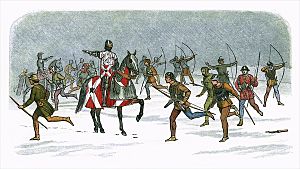
The Lancastrians were happy to wait for their enemies to come to them. So, the Yorkists made the first move. Fauconberg noticed the strong wind. He ordered all Yorkist archers to step forward. They shot their arrows from the farthest possible range. With the wind behind them, the Yorkist arrows flew farther than usual. They landed deep into the large groups of Lancastrian soldiers.
The Lancastrian archers' response was not good. The strong wind blew snow into their faces. It was hard for them to guess the distance and hit their targets. Their arrows fell short of the Yorkist lines. Fauconberg had told his men to pull back after shooting one volley. This way, they avoided getting hit. The Lancastrians kept shooting their arrows until most were gone. This left a thick carpet of arrows on the ground in front of the Yorkists.
After the Lancastrians stopped shooting, Fauconberg told his archers to step forward again. When they ran out of their own arrows, the Yorkists picked up the arrows shot by their enemies from the ground. They kept shooting these arrows. The Lancastrian army was being attacked without being able to fight back effectively. So, they moved from their position to attack the Yorkists in close combat. Seeing the large group of men coming, the Yorkist archers shot a few more volleys. Then they moved behind their own soldiers, leaving thousands of arrows on the ground to slow down the Lancastrian attack.
As the Yorkists got ready for the Lancastrian charge, their left side was attacked. Horsemen came from Castle Hill Wood. The Yorkist left wing became messy, and some soldiers started to run away. Edward had to take charge of the left wing himself to fix the situation. He joined the fight and encouraged his men. His example inspired many to stay and fight. The armies clashed, and archers shot into the crowd of men from close range. The Lancastrians kept sending in fresh soldiers. Slowly, the Yorkist army, which had fewer men, was pushed back up the southern ridge.
The fighting continued for three hours. It was not clear who would win until Norfolk's men arrived. They marched up the Old London Road and attacked the Lancastrian left side. The Lancastrians kept fighting, but the Yorkists now had the advantage. By the end of the day, the Lancastrian line broke apart. Small groups of men started running away to save their lives. Some old records say the battle lasted for 10 hours in total.
The End of the Battle
The tired Lancastrians threw off their helmets and armor to run faster. Without this protection, they were much easier targets for the Yorkists. Norfolk's soldiers were fresh and fast. Many Lancastrians were cut down from behind as they ran across what became known as Bloody Meadow. Others were killed after they had given up. Before the battle, both sides had said they would not take prisoners. The Yorkists were not in the mood to spare anyone after such a long, hard fight. Some Lancastrians, like Trollope, also had large rewards on their heads. One old record says 42 knights were killed after being captured.
Archaeological discoveries in the late 1900s showed more about the end of the battle. In 1996, workers found a mass grave in Towton. Archaeologists believe it held the remains of men killed during or after the battle in 1461.
More Lancastrian soldiers died while running away than during the actual fighting. Men trying to cross the river were pulled under by the currents and drowned. Those who struggled were stepped on and pushed underwater by their comrades. As the Lancastrians tried to cross the river, Yorkist archers went to high spots and shot arrows at them. The dead bodies started to pile up. The chase continued north across the River Wharfe, which was larger than Cock Beck. A bridge over this river collapsed under the weight of so many men. Many drowned trying to cross. Those who hid in Tadcaster and York were hunted down and killed.
A report from April 1461 said 28,000 people died in the battle. Historians believe this number was too high. Other old sources gave higher numbers, from 30,000 to 38,000. One source said the Lancastrians had 9,000 deaths, which historians think is more likely. A recent study suggests the total number of deaths was between 2,800 and 3,800.
Many Lancastrian nobles died. The Earl of Northumberland, lords Welles, Mauley, and Dacre, and Sir Andrew Trollope were killed in battle. The earls of Devon and Wiltshire were captured and then executed. Lord Dacre was said to have been killed by an archer hiding in an elder tree. In contrast, the Yorkists lost only one important person, Horne, at Towton.
What Happened After Towton?
When King Henry heard his army was defeated, he fled to Scotland with his wife and son. They were later joined by Somerset and other Lancastrian nobles who escaped. The Battle of Towton greatly weakened the House of Lancaster in England. Their main supporters were dead or had fled, ending their power in northern England. Edward declared 14 Lancastrian nobles to be traitors. About 96 other Lancastrians were also punished by law.
The new king, Edward, preferred to win over his enemies. The nobles he punished were either dead or had refused to surrender to him. Edward took some of their lands, but most were left with their families. Edward also forgave many of those he had punished once they accepted his rule.
Even though Henry was still free in Scotland, the battle settled who was king for a while. The English people now believed Edward was the true king. Edward focused on making his rule strong. He tried to win over the people and stop any remaining Lancastrian rebellions. He made many of his supporters knights and gave some of them higher noble titles. Fauconberg became the Earl of Kent.
Warwick gained a lot from Edward's rule after the battle. He received parts of Northumberland's and Clifford's lands. He was also made "the king's lieutenant in the North and admiral of England." Edward gave him many powerful and rich positions, making Warwick even more influential.
By 1464, the Yorkists had stopped all Lancastrian resistance in northern England. Edward's rule was not interrupted until 1470. By then, his relationship with Warwick had become so bad that Warwick joined the Lancastrians. Warwick forced Edward to flee England and put Henry back on the throne. But Yorkist rule did not stop for long. Edward regained his throne after defeating Warwick and his Lancastrian allies at the Battle of Barnet in 1471.
Towton in Stories and History
In the 1500s, William Shakespeare wrote plays about historical figures. He used history to make his plays feel real. Shakespeare wrote a three-part play about Henry VI. He used an old record called Hall's chronicle a lot. His version of the Battle of Towton, in Henry VI, Part 3, Act 2, Scene 5, was shown as the "bloodiest" battle of the Wars of the Roses. It became a famous scene about the horror of civil war, especially how it affected families.
Shakespeare's play shows a famous scene right after Henry's speech. Henry sees two soldiers crying in the battle. One soldier kills his opponent hoping for treasure, only to find it's his own son. Another soldier kills his enemy, who turns out to be his father. Both killers acted out of greed. They felt deep sadness after realizing what they had done. In this scene of sadness, Shakespeare uses made-up characters to show the problems of civil war. Meanwhile, the historical king thinks about their sad fates. This scene shows Henry's sadness about the war. It also makes the audience feel the same way and shows how bad Henry was as a king.
The Battle of Towton was also looked at by Geoffrey Hill in his poem "Funeral Music" (1968). Hill tells the story through the voices of the soldiers who fought. He shows the chaos of the time through their eyes. The common soldiers complain about being uncomfortable and the sacrifices they made. They shared their leaders' desire to destroy their enemies, even if it meant dying. Hill suggests that the idea that the battle was super important was a joke. The world kept going no matter what happened at Towton.
Legacy
It has been hard to find an exact number of people who died at Towton.
Old documents from the 1400s say some dead soldiers were reburied in graveyards at Saxton. A chapel was started for this purpose by Richard III in 1484. But he died at the Battle of Bosworth in 1485, so the building was never finished. It eventually fell apart. In 1929, stones believed to be from this chapel were used to make the Towton Cross. This cross, also called Lord Dacre's Cross, remembers those who died in the battle.
Lord Dacre was buried at the church of All Saints in Saxton. His tomb was well cared for in the late 1800s, though some parts had worn away. The tree from which Dacre's killer supposedly shot his arrow was cut down by the late 1800s. In 2010, parts of some of the oldest known handguns in Britain were found on the battlefield.
For centuries, people's ideas about the Wars of the Roses and the Battle of Towton were shaped by Shakespeare. They saw it as a very bloody event. However, by the early 2000s, this "largest and bloodiest battle ever fought on English soil" was not as well known. British journalists felt people did not know about the Battle of Towton or how important it was. According to English Heritage, a government group, the battle was very important. It was one of the largest battles in England. It also led to a new royal family taking over. Hill had a different idea. He was impressed by the number of deaths, but he believed the battle did not bring huge changes to the lives of English people.
The Battle of Towton was linked to an old tradition in the village of Tysoe, Warwickshire. For many centuries, a local farmer would clean a hill figure, the Red Horse of Tysoe, every year. This was part of his land agreement. No one knows for sure where this tradition came from. But people in the area said it was to remember the Earl of Warwick. He supposedly killed his own horse to show he would stay and fight with his soldiers. This tradition ended in 1798. This was when new laws changed common land into private property. The cleaning was brought back in the early 1900s but has stopped again since then.
See also
 In Spanish: Batalla de Towton para niños
In Spanish: Batalla de Towton para niños


